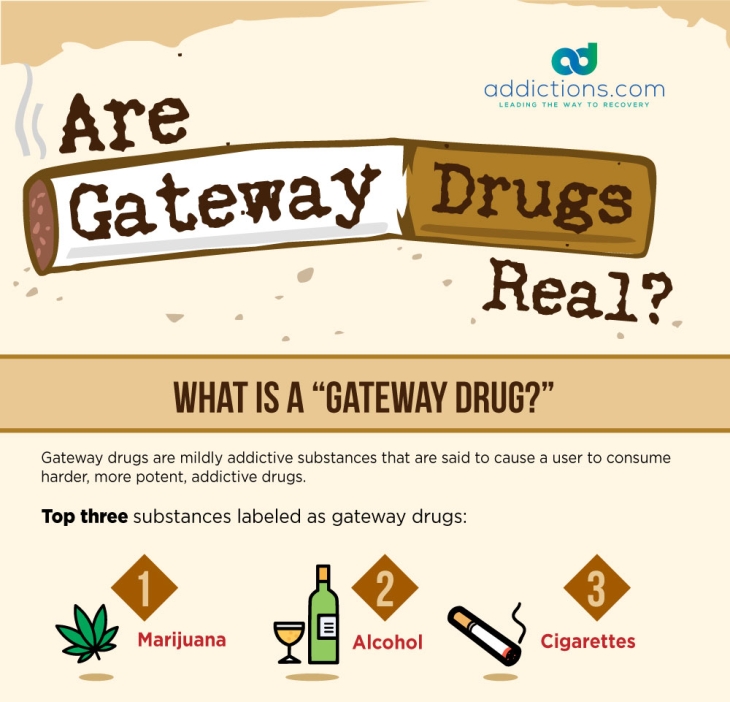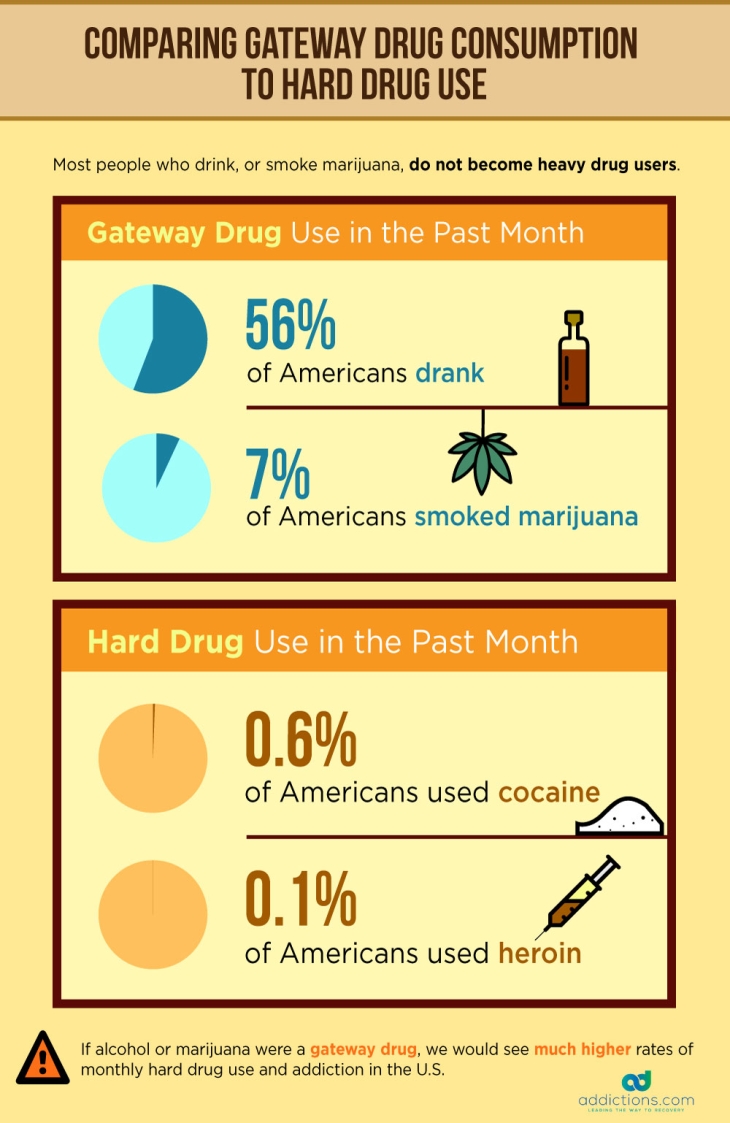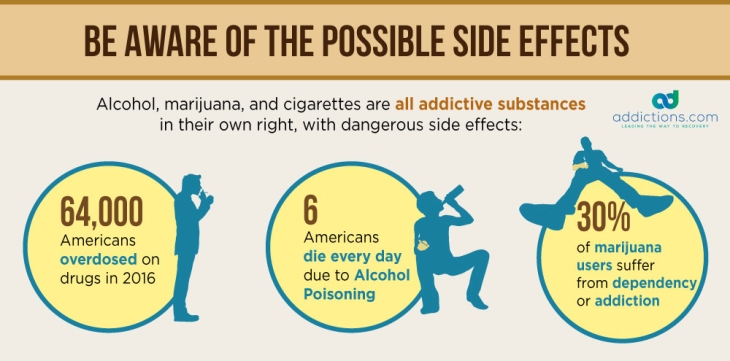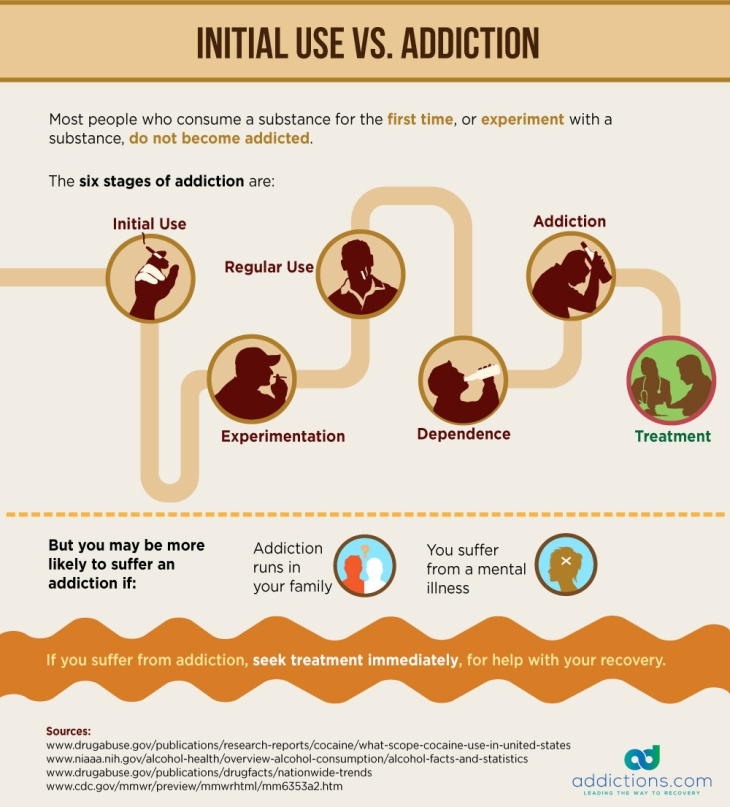Gateway drugs are generally known as mildly addictive substances that can eventually lead to the use of “harder,” more potent, addictive drugs. Over the years, a countless number of educators, lawmakers, politicians, and even our parents have warned us to stay away from cigarettes, alcohol, and marijuana, as these substances are viewed as “gateways” to harder, more dangerous drugs. But are gateway drugs real, and can they truly lead to serious problems with physical dependence and addiction?
In the United States, the stigma and concept surrounding gateway drug use has been magnified and exaggerated on behalf of political campaigns and crisis such as the War on Drugs and the nationwide opioid epidemic. For many years, despite all the noise surrounding gateway drugs, there was little scientific evidence existing that proved these drugs increase the risk for dependence and addiction. This lack of evidence has had scientists and Americans questioning whether gateway drugs are real, or just scare tactics being used to sway people from using drugs and alcohol.
Regardless of whether gateway drugs are real or not, addiction itself IS real, and can lead to serious problems with one’s career, relationships, health, and overall livelihood.
Here’s an in-depth look at the history behind gateway drugs, and into whether these substances really do increase the risk for dangerous illicit drug use, physical dependence, and addiction.
The History Behind Gateway Drugs
The concept behind gateway drugs, or the “gateway effect,” was originally developed during the 1970s, when scientists suggested that experimenting with alcohol, tobacco, or marijuana during one’s teenage years increased the risk for use of stronger illicit drugs later in life. Scientists theorized that teens began their descent into hard drug use and addiction with tobacco and alcohol, followed by cannabis, and then by harder, illicit drugs like cocaine and heroin. After this study was released in 1975, countless other studies were conducted to examine the link between gateway drugs, and dependence and addiction — all of which produced mixed results.
Scientists and researchers initially came up with theories surrounding the effects of gateway drugs after discovering that certain substances could enhance or increase the effects of other substances. Early studies were conducted on animals to examine the effects on the brain when two or more drugs were combined — leading to findings that revealed how certain drug combinations can alter neurotransmitters in the brain. Unfortunately, results from many 1970s studies on gateway drugs were skewed and incomplete, given scientists failed to take other addiction risk factors into consideration such as environment, genetics, and co-existing mental health disorders.
Many studies conducted on gateway drugs did not prove that the use of mildly addictive substances led to the use of more highly addictive substances at any point in life. But despite these findings, the gateway drug theory became more popularized in U.S. society and culture as years ticked by. The phrase “gateway drugs” wasn’t coined until the 1980s, when anti-drug activists developed this term to support emerging anti-drug laws and policies.
Today, the gateway drug theory is being more closely scrutinized by scientists and lawmakers — especially since marijuana legalization is becoming more widespread throughout the U.S., and opioid addiction is found to be driven by a number of causes other than gateway drug use. While the gateway drug theory may help deter some from experimenting with certain drugs, debunking the theory could work in favor for Americans who could benefit from using drugs like painkillers and marijuana for therapeutic reasons without putting themselves at risk for addiction.
Substances Commonly Viewed as “Gateway Drugs”
Substances that are most commonly viewed as gateway drugs are those that are habit-forming, but that also carry a mild risk for addiction. Most gateway drugs are legal, and generally considered “soft” when compared to highly addictive illicit drugs like heroin, crystal meth, and cocaine.
Here are substances most commonly recognized as gateway drugs in the U.S.
Marijuana
Marijuana does carry its own mild risk for dependence and psychological addiction, and is now becoming legal for medicinal and recreational use throughout the U.S. But is marijuana a gateway drug? A recent study found that adults who use marijuana are more likely to develop alcohol use disorder within three years than those who do not use marijuana. However, not all who suffer alcohol use disorder started smoking marijuana before they tried alcohol. Additionally, evidence shows that the majority of marijuana users do not progress to the use of harder, illicit substances like cocaine, meth, and heroin.
Alcohol
Many tend to cite marijuana as the ultimate gateway drug, when in fact, evidence points toward alcohol being the true gateway drug. In a federal study involving 2,800 12th graders from around the U.S., 54 percent revealed they started using alcohol first before trying any other substance. In the U.S., alcohol is legal and socially acceptable, with 56 percent of Americans reporting drinking alcohol within the past month.
Cigarettes
Like alcohol, smoking is legal and commonly viewed as socially acceptable in most groups. But nicotine is a stimulant, and can lead to the use of stronger, more powerful stimulants like cocaine and methamphetamine in some individuals. Evidence shows that a high number of teens who smoke eventually move on to trying alcohol, marijuana, and other substances, but may not necessarily become physically dependent on those substances.
A 2011 national survey found that 90 percent of U.S. cocaine users between the ages of 18 and 34 started smoking cigarettes before they started using cocaine. However, not all who try cigarettes or who smoke regularly ever try or experiment with cocaine. In the U.S., over 15 percent of the population smokes cigarettes regularly, but less than one percent use cocaine.
Painkillers
Painkillers are also known as opioids, which are among some of the most highly addictive drugs in the world, and one of the leading drivers behind the U.S. opioid overdose epidemic. Painkillers are viewed as a gateway drug mainly because these drugs are highly accessible, highly addictive, and frequently lead to heroin use. A person who misuses their prescription whether intentionally or not can quickly become dependent on painkillers in a matter of days or weeks.
Evidence shows that prescription painkiller abuse is a major risk factor for heroin use. Those who use painkillers for nonmedical reasons are 19 times more likely to start using heroin than those who do not use painkillers. At the same time, not all heroin users experimented with using prescription painkillers before turning to heroin.
Prescription Drugs
Prescription drugs including benzodiazepines, sleep aids, and stimulants used to treat ADHD are also commonly viewed as gateway drugs, since these substances are often easily accessible from friends, family, and doctors. Those who start misusing their prescriptions, or who steal or accept these drugs from friends and family can unintentionally become dependent and addicted. For instance, a person using Ritalin or Adderall to treat ADHD may start using cocaine in an effort to achieve higher levels of focus and concentration.
So Are Gateway Drugs Real, or a Myth?
A recent report published in Preventive Medicine found that there was no correlation between alcohol, tobacco, and marijuana use during teen years, and increased use of these and other illicit drugs during adulthood. To arrive at this conclusion, researchers examined drug use patterns in study participants who were followed in the years between adolescence and adulthood. This evidence was then combined with results from previous studies conducted on the effects of gateway drugs to reveal that gateway drugs are, in fact, a myth.
While evidence does show that those who use harder substances like heroin and cocaine also tend to smoke and consume alcohol, not everyone who smokes and consumes alcohol uses hard substances. Additionally, many who smoke and drink don’t even try or experiment with hard substances at all during their lifetime. After a number of recent emerging studies debunked the gateway drugs theory, the DEA removed pages from its website that suggested marijuana is a gateway drug linked to dangerous consequences including psychosis and permanent brain damage.
Another study examined initial drug use across cultures and contexts to determine whether use of gateway drugs leads to harder drug use across the globe. Results showed that initial use of harder, illicit drugs was most commonly caused by one’s environment and degree of exposure to drugs.
Though the gateway drugs theory may be myth, it’s important to understand the stages of addiction, and how alcohol, nicotine, marijuana, and painkillers can lead to the use of harder, illicit drugs. Substances viewed as mildly addictive still pose a risk for dependence and addiction, which can be made even higher with certain risk factors.
The Truth Behind Addiction
Addiction begins with initial use, segues into experimentation, and can eventually turn into regular use. Regular use is then followed by tolerance and physical dependence before it turns into a full-blown addiction. But experimenting with gateway drugs doesn’t necessarily mean that regular use, dependence, and addiction is inevitable, and on the horizon.
Gateway drugs do carry a potential risk for dependence and addiction due to the way all these substances affect the brain. When someone uses a gateway drug regularly, they become tolerant of their usual amount, and start requiring a higher amount to achieve the drug’s effects. Many times, these individuals turn to stronger drugs in the same drug class to experience the same effects, but at a heightened, more intense level. For example, a person who uses prescription morphine may start using heroin — an illicit opioid up to three times stronger than morphine.
People become addicted to drugs and alcohol for different, unique reasons which don’t always involve using gateway drugs for recreation or experimentation. These reasons may be cultural, genetic, and stem from one’s mental health status. Eliminating gateway drugs like marijuana won’t eliminate addiction, since addiction is a chronic relapsing brain disease that doesn’t discriminate based on the substance being used. Plus, a person who uses gateway drugs won’t always necessarily move on to trying and using harder drugs.
To further reduce the stigma surrounding addiction and “gateway drugs,” the U.S. as a whole can benefit from raising awareness about the effects of alcohol, marijuana, nicotine, and painkillers, and about how abusing these substances can lead to dependence and addiction. Increasing access to addiction treatment and providing drug education in school, community, and health settings can also help U.S. communities lower the impact of addiction.
How Addiction Treatment Centers Can Help
Substance use disorders are commonly treated using detoxification and psychological therapy. Detox helps patients overcome physical dependence on drugs — including gateway drugs like marijuana and painkillers — while psychological therapy helps patients overcome the root cause of their addiction. For instance, someone who started abusing painkillers and then moved on to heroin to avoid symptoms of depression can safely withdraw from heroin with detox, then receive behavioral therapy and counseling to learn how to manage or overcome depression.
Addiction treatment centers will customize therapies for each individual patient based on their unique, personal recovery needs. Special treatment programs are also available for teens, seniors, and different genders so patients can choose a recovery environment in which they feel most comfortable. For example, teens who started smoking cigarettes or using marijuana can participate in youth addiction treatment programs and bond with peers their same age who face similar struggles that led them to drug use.




